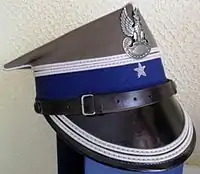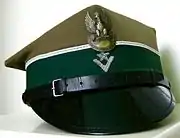Rogatywka
Rogatywka (Polish pronunciation: [rɔɡaˈtɨfka]; sometimes translated as peaked cap) is the Polish generic name for an asymmetrical, peaked, four-pointed cap used by various Polish military formations throughout the ages. It is a distant relative of its 18th-century predecessor, konfederatka (because of use by members of the Bar Confederation), although similar caps have been used by light cavalry since the 14th century. It consists of a four-pointed top and a short peak, usually made of black or brown leather. Although rogatywka (derived from róg which means horn or corner) in English seems to mean the same as czapka, the word 'czapka' in Polish designates not only rogatywka, but all caps (not hats).



Konfederatka
The konfederatka was based on the hats of the Lithuanian Tatar national costumes of the 18th century, as the Vanguard regiments of the army of the Grand Duchy of Lithuania was heavily influenced by the dress of Lithuanian Tatars, among other elements.[1]
Usage
The rogatywka usually comes in two variants: the hardened and soft version. The hardened model, based on the rogatywka Mk. 1935, olive green with black peak, is used in full gala uniforms, while the rim colour marks unit type (for example, navy blue - typical, scarlet - military police, green - artillery, and so on). It was not worn during most of the People's Republic of Poland era but was reintroduced for ceremonial wear by the Honour Guard Company in 1983. The soft version was used before World War II and during the People's Republic of Poland period for garrison dress; it was withdrawn after 1990.
Polish soldiers, unlike those of most military forces, decorate their caps not with the emblem of their corps, but with their service's version of the Polish military eagle. The military eagle insignia is based on an early 19th-century design, comprising a modified White Eagle (from the Polish coat of arms) perched atop an 'amazon shield'.
Army branches are indicated by the following colored cap bands:
- navy blue – generals, mechanized troops, legal corps, logistics corps, National Honour Guard
- orange – units dedicated to honour historical armoured troops, scouts
- dark green – rocket forces, artillery, anti-aircraft units
- black – engineering units, chemical corps, cartographic service, technical cadets
- cornflower – adjutant general corps, radio and communication corps
- cherry – medical service, medical cadets
- scarlet – military police
- violet – chaplains
- yellow – headquarters of 1st Warsaw Mechanized Division, 1st Warsaw Armoured Division
Others
The rogatywka is used by Polish firefighters (hardened, all navy blue) and Polish State Railways staff (soft, navy blue or red).
Green rogatywkas with brown leather peak and scout Fleur-de-lis symbol are traditionally worn by Polish boy scouts, while grey caps are sometimes used by girl guides.
 Rogatywka design 1919
Rogatywka design 1919 Rogatywka design 1936
Rogatywka design 1936 Młodszy chorąży cap
Młodszy chorąży cap PRL era field cap
PRL era field cap A soldier from the Representative Honor Guard Regiment of the Polish Armed Forces
A soldier from the Representative Honor Guard Regiment of the Polish Armed Forces
References
| Wikimedia Commons has media related to Rogatywka. |
- Rakutis, Valdas; Vaičenonis, Jonas (2012). Lietuvos Didžiojo Kunigaikščio Algirdo Mechanizuotojo Pėstininkų Bataliono Istorija (PDF). Vilnius: Generolo Jono Žemaičio Lietuvos karo akademija. p. 56. ISBN 978-609-8074-00-0.